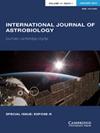炒作,游戏中的皮肤,以及合作科学的稳定性
IF 1
4区 物理与天体物理
Q3 ASTRONOMY & ASTROPHYSICS
引用次数: 1
摘要
我们解决了最近提出的一个问题:“为什么这么多天文学(和天体生物学)发现没有达到预期?”我们将其扩展到一般科学领域的炒作。我们的答案依赖于应用于研究科学的游戏中炒作和皮肤的有效定义,以及合作科学稳定性的博弈论模型。游戏中的低皮肤允许研究科学界内部的反馈,引发更多的炒作和结构不稳定。这种不稳定性导致合作均衡的恶化,这进一步加剧了炒作。随着时间的推移,随着突破而炒作的结果数量将增加,更多的索赔将达不到炒作的效果。这可能导致公众认为科学正在倒退,并改变对科学家和科学价值观的看法。尽管炒作的不稳定性可能是由外部推动引起的,但系统的内部动态,即工作科学家的集体,发挥了更大的作用。同样,对不稳定倾向的修正也应侧重于内部结构。关于研究传播方式的拟议外部转变将给一个弊大于利的系统增加限制。本文章由计算机程序翻译,如有差异,请以英文原文为准。
Hype, skin in the game, and the stability of cooperative science
We address a recently posed question: ‘Why Do So Many Astronomy (and Astrobiology) Discoveries Fail to Live Up to the Hype?’ We expand it to cover hype within science in general. Our answer relies on working definitions of hype and skin in the game, as applied to research science, and a game theory model for the stability of cooperative science. Low skin in the game allows internal feedbacks, within the research science community, to initiate increased hype and a drift toward structural instability. The instability leads to the deterioration of cooperative equilibria, which further enhances hype. Along the drift, the number of results hyped as breakthroughs will increase and more claims will fail to live up to the hype. This can lead to the public perception that science is moving backwards and a shift in the perception of what scientists, and science, values. Although a hype instability can be initiated by external nudges, a bigger role is played by the internal dynamics of the system, i.e. the collective of working scientists. Corrections for a drift toward instability should, likewise, focus on internal structure. Proposed external shifts on how research is disseminated will add restrictions to a system that can do more harm than good.
求助全文
通过发布文献求助,成功后即可免费获取论文全文。
去求助
来源期刊

International Journal of Astrobiology
地学天文-地球科学综合
CiteScore
3.70
自引率
11.80%
发文量
45
审稿时长
>12 weeks
期刊介绍:
International Journal of Astrobiology is the peer-reviewed forum for practitioners in this exciting interdisciplinary field. Coverage includes cosmic prebiotic chemistry, planetary evolution, the search for planetary systems and habitable zones, extremophile biology and experimental simulation of extraterrestrial environments, Mars as an abode of life, life detection in our solar system and beyond, the search for extraterrestrial intelligence, the history of the science of astrobiology, as well as societal and educational aspects of astrobiology. Occasionally an issue of the journal is devoted to the keynote plenary research papers from an international meeting. A notable feature of the journal is the global distribution of its authors.
 求助内容:
求助内容: 应助结果提醒方式:
应助结果提醒方式:


